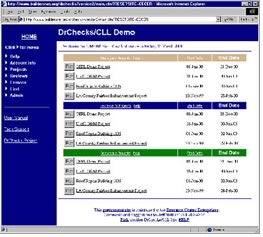
Internet-based review system available to private A/Es in June
Army Engineer Research and Development Center
U.S. Army Corps of Engineers
 By
putting technology to work, the State Department's Overseas Building Operations
(OBO) is expediting design reviews for new embassies and security upgrades
at 260 U.S. overseas posts. OBO has adopted the Design Review and Checking
System (DrChecks)—a Web-based collaboration tool developed by the
U.S. Army Corps of Engineers' Construction Engineering Research Laboratory
(CERL)—as a standard practice. DrChecks saves the OBO time and money
while helping produce better designs for the facility life-cycle.
By
putting technology to work, the State Department's Overseas Building Operations
(OBO) is expediting design reviews for new embassies and security upgrades
at 260 U.S. overseas posts. OBO has adopted the Design Review and Checking
System (DrChecks)—a Web-based collaboration tool developed by the
U.S. Army Corps of Engineers' Construction Engineering Research Laboratory
(CERL)—as a standard practice. DrChecks saves the OBO time and money
while helping produce better designs for the facility life-cycle.
As all architects know, although the design phase is a fraction of a structure's life-cycle cost, design-phase decisions ultimately dictate most operation and maintenance costs. When OBO design managers relied on a physical exchange of paper review comments, managing the voluminous quantity from geographically dispersed project teams proved time-consuming and tedious. DrChecks, on the other hand, links all users via a secure, Internet-based client-server system. It has a user-specific interface so that each person sees only those functions and information appropriate for the job at hand.
Right time, right
place
OBO is responsible for some 12,000 properties, including embassies, consulates,
residences, warehouses, offices and other support structures, plus Marine
Corps housing. According to Maj. Gen. (Ret.) Charles E. Williams, OBO's
director and chief operating officer, the agency began a concerted effort
to improve embassy security after the 1998 terrorist bombings in Africa.
The September 11 attacks on the U.S., he says, "have us continuing
the upgrades in an intensified mode with even more vigilance." Basic
protective measures focus on perimeter defense, building and structural
integrity, and proper access control points.
Williams took charge of OBO in spring 2001 and began an ambitious reorganization. The intent was to seek out best business practices and use them to create standard procedures that would streamline and refocus the organization. In the design review phase, this means involving all stakeholders to improve the process of first identifying significant design issues and then reaching timely resolution using DrChecks.
 Developed
by Corps' CERL, now part of ProjNet
Developed
by Corps' CERL, now part of ProjNet
The State Department routinely monitors emerging technology and, seeing
a potential benefit in CERL's DrChecks, launched it in a pilot program
in 1999. "We couldn't initially do business on the Internet because
much of our design work is sensitive," explains Robert Clarke, architect
and design information technology manager in OBO's Design and Engineering
Branch. "As a result of our security concerns, we originally rolled
DrChecks out on the Department's secure Intranet, where it's been operating
for several years. With Director Williams' new emphasis on e-business
solutions, we've been able to work with the Corps in implementing a secure
Internet solution using VPN [verified pin number] technology."
CERL has been working with OBO to provide several enhancements to DrChecks under the development name "PROJect NETwork (ProjNet)." These enhancements include access to an "e-government" site, portal tools, and FILER, a system that will allow secure file transfer over the Internet. It is this system that will be made available to private architecture and engineering firms.
Integrated Design
Review Process
DrChecks' growing popularity has made it a standard tool in a new process
titled "Integrated Design Review Process." This restructured
process has six steps:
1. Review kick-off meeting, In the review kick-off meeting, the OBO design team validates the design submittal's completeness, correct security handling, and project cost. The review team will reject submittals at this step that are over budget, incomplete, or have security-classification issues.
2. Collaborative review, during which reviewers enter comments into DrChecks, which tracks the comments and actions, providing a complete history of each one plus reviewers' contact information so that users can easily follow up. By publishing comments in real time to all reviewers, the tool allows for a more collaborative process.
3. Technical coordination, which is accomplished through an internal OBO meeting to screen for inappropriate, redundant, and conflicting review comments. OBO's design reviews show that, on average, 20 percent of the issues are eliminated at this step, before comments are sent to the A/E partner.
4. Designer response allows the A/Es and contractors to use DrChecks as a structured means for indicating concurrence or nonconcurrence and tag each comment for potential impact on cost, scope, or schedule. By the conclusion of this stage, 70 percent of all review issues usually are resolved.
5. Reviewer backcheck, in which each originating reviewer closes issues in DrChecks or, if any are left open, explains why the A/E's response was not acceptable. An additional 18 percent of the issues are resolved at this phase of the review.
6. Integrated design review meeting, held at a "war room" newly built at OBO for this purpose, allows all stakeholders (either in person or via teleconferencing) to close the remaining 12 percent of issues online. The meeting concludes when all comments have been closed and all design stakeholders have agreed on their resolution.
 "DrChecks
puts more discipline and consistency into the design review documents
than was possible before," Williams says. "Negotiations are
friendlier because the government's position is clearly stated through
the requirements—and this helps avoid disputes in the first place."
"DrChecks
puts more discipline and consistency into the design review documents
than was possible before," Williams says. "Negotiations are
friendlier because the government's position is clearly stated through
the requirements—and this helps avoid disputes in the first place."
"Significant
advantages"
According to OBO's Clarke, DrChecks has three significant advantages in
the design process:
• Reduced time to collate and coordinate multiple formats of paper
and electronic documents. Based on a $100 million project, he says, a
"conservative estimate of our internal savings is 60 man-hours of
processing time avoided."
• Speedier design review, in part due to the quicker processing time
but also related to faster, more efficient dispute resolution. OBO has
cut about 20 days from each design review and—for the same baseline
$100 million project and a 3 percent inflation growth factor—this
avoids $167,000 in construction costs.
• Improved design quality and associated reduction in change orders
and delays—a savings that has been conservatively estimated at about
one-quarter of 1 percent for each project. Against the same $100 million
in construction dollars, this translates into another $250 thousand in
costs avoidance. The total savings from improved design review is therefore
$500,000 for this project, so that DrChecks has had a less than one-year
payback at OBO.
Data collection
In addition to facilitating OBO's design review process, DrChecks documents
savings and operational data that give the agency a powerful tool for
assessing and improving its business practices. With 500 users and 46,000
comments entered for 403 projects since 1998, trends have emerged that
show the system's benefits.
Information tracked in DrChecks also allows OBO to pinpoint technical areas for which comments are most prevalent. This type of data helps OBO improve and clarify its design guidelines and project definition documents, statements of work, and requests for proposals by focusing on areas that produced the most comments. In addition, the system can show OBO which A/E contractors most often reject or nonconcur with review comments across different projects and disciplines.
Available to private
A/Es in June
Government agencies subscribe to ProjNet through a memorandum of agreement
with CERL. Private owners and designers will also be able to acquire these
tools through commercial subscription services scheduled to begin operation
in June 2002. More
information is available online or by contacting Bill
East, 217-373-6710, or
Jeff Kirby, 217-373-6730.
Copyright 2002 The American Institute of Architects. All rights reserved.
![]()
|
|
|